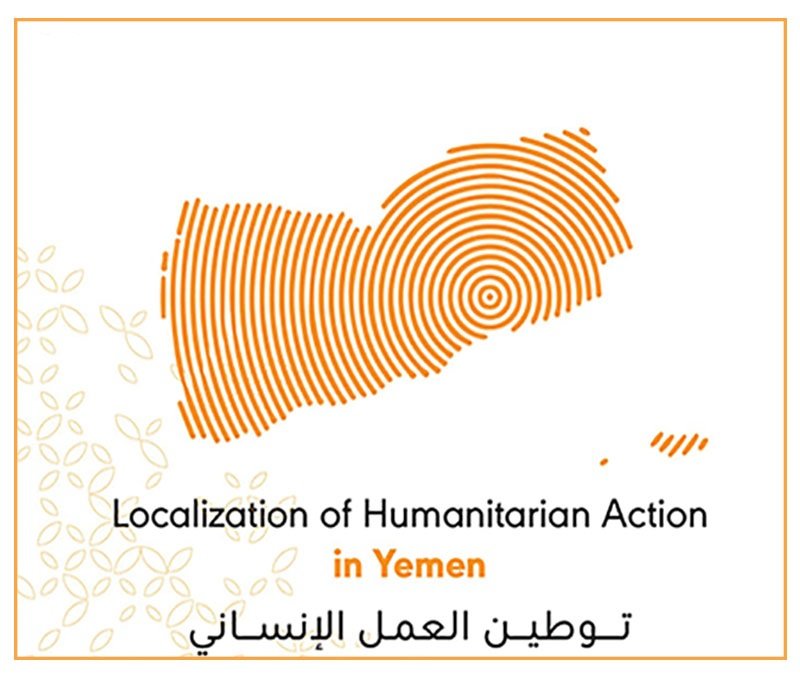نظرة عامة على مقترح استراتيجية
التوطين
الرؤية
الرسالة
لتحقيق رؤيتنا، نحن
ملتزمون بتمكين أصحاب المصلحة المحليين من خلال الدعوة للشراكات الاستراتيجية
والمبادرات القيادية. ونحن نسعى جاهدين للدعوة إلى تعزيز آليات التنسيق والتكامل،
وخلق بيئة تشجع وتمكن الجهات الفاعلة المحلية من لعب أدوار محورية في عملية
الاستجابة. من الأمور الأساسية في مهمتنا هو الالتزام ببناء قدرات الكيانات
المحلية وتسهيل وصولها إلى الأموال النوعية والكمية.
ومن خلال متابعة هذه
المهمة، نهدف إلى إحداث تأثيرات إيجابية دائمة، وتعزيز نظام استجابة أكثر
استقرارًا وكفاءة وقيادة محلية يضمن رفاهية المجتمعات المحلية وقدرتها على الصمود
في جميع أنحاء اليمن.
الهدف العام:
الهدف
العام لمبادرة التوطين هو الترويج لنظام استجابة أكثر محلية وشمولية واستجابة
وفعالية في اليمن، ويتميز بتعزيز الشراكات، وتمكين القيادة المحلية، وتعزيز
التنسيق، وزيادة مشاركة المجتمع والملكية، وتحسين إمكانية الوصول إلى التمويل،
ودعم البيئة للجهات الفاعلة المحلية. ويهدف هذا الهدف الشامل إلى تعزيز التدخلات
المستدامة والمؤثرة التي تتماشى مع احتياجات السكان المتضررين، مما يؤدي تدريجياً
إلى تضخيم دور وقدرات الجهات الفاعلة المحلية مع ضمان المشاركة العادلة والأخلاقية
في مشهد الاستجابة.
إنها
حركة ديناميكية توفر الأساس لتعميم توطين الاستجابة في اليمن والتي تتصور بذل جهد
تعاوني يشمل أعضاء مبادرة التوطين والجهات الفاعلة في الاستجابة وأصحاب المصلحة.
وتتمثل مهمتها في وضع تدابير استراتيجية تعطي الأولوية لتعزيز الشراكات المحلية،
وتمكين القيادة المحلية، وتعزيز التنسيق والتكامل، وتعزيز المشاركة المجتمعية
والملكية، والدعوة إلى بيئة مواتية للجهات الفاعلة المحلية، وتعزيز القدرات
المؤسسية، وتحسين إمكانية الوصول إلى التمويل وجودته.
القيم:
- إنسانية: الالتزام بالحفاظ على حياة
وكرامة ورفاهية الأفراد المتأثرين بالأزمات وحمايتها دون تمييز على أساس
الجنسية أو العرق أو الدين أو عوامل أخرى.
- الحياد: الحفاظ على الحياد والامتناع
عن الانحياز إلى أي طرف في النزاعات أو الخلافات، وضمان تقديم المساعدة على
أساس الحاجة فقط، دون محاباة.
- الحياد: تقديم المساعدة والدعم فقط
على أساس الحاجة، دون أي شكل من أشكال التحيز أو التمييز، بما يضمن المساواة
في المعاملة بين المحتاجين للمساعدة.
- استقلال: تنفيذ الأعمال الإنسانية
بشكل مستقل وخالي من التأثيرات السياسية أو الاقتصادية أو غيرها من التأثيرات
الخارجية، مما يسمح باتخاذ القرارات بناءً على الاحتياجات الإنسانية وحدها.
- عدم التمييز: الإيمان بأن المبادئ
الإنسانية والمساعدات يجب أن تكون متاحة لجميع الأفراد المتضررين من الأزمات،
بغض النظر عن موقعهم أو خلفيتهم أو انتمائهم.
- مسئولية: تحمل المسؤولية عن الإجراءات
والقرارات، والمسؤولية عن عواقب التدخلات الإنسانية، والشفافية بشأن استخدام
الموارد والنتائج المحققة.
- احترام حقوق الإنسان: دعم وتعزيز
احترام حقوق الأفراد المتأثرين بالأزمات، وضمان عدم انتهاك الأعمال الإنسانية
لحقوقهم الأساسية.
المبادئ:
- الملكية والقيادة المحلية: إعطاء الأولوية
للجهات الفاعلة المحلية ودعمها في قيادة وتشكيل التدخلات، مع احترام خبراتهم
ومعرفتهم بالسياق.
- محاذاة الشراكة: التأكد من أن الشراكات مبنية
على الاحترام المتبادل والشفافية والمبادئ المشتركة، وتعزيز العلاقات
التعاونية التي تعمل على تضخيم التأثير.
- النهج المبني على الاحتياجات: تصميم وتنفيذ
البرامج بناءً على فهم شامل للاحتياجات المتنوعة والمتطورة للمجتمعات
المتضررة.
- الشمولية والتنوع: احتضان التنوع والشمول من
خلال ضمان مشاركة جميع أصحاب المصلحة، وخاصة الفئات المهمشة، وتقييم
مساهماتهم.
- المساءلة والشفافية: التمسك بمعايير
عالية من المساءلة والشفافية والسلوك الأخلاقي في جميع التفاعلات وعمليات صنع
القرار.
- التعلم المستمر والتكيف: تعزيز ثقافة
التعلم والتكيف، مما يسمح بالمرونة والابتكار استجابة للظروف المتغيرة وردود
الفعل.
- الاستدامة والمرونة: تعزيز التدخلات
المستدامة، وبناء القدرة على الصمود داخل المجتمعات لضمان التأثير الإيجابي
الدائم بما يتجاوز الاستجابة الفورية للأزمات.
- الدعوة والتأثير: الدعوة إلى السياسات
والممارسات التي تدعم أجندة التوطين وإزالة العوائق التي تحول دون المشاركة
المحلية الفعالة في النظام الإنساني.
- حساسية الصراع وعدم الإضرار: إعطاء الأولوية
لحساسية الصراع في جميع التدخلات، والسعي لعدم الإضرار وتقليل الآثار السلبية
على ديناميات الصراع.
الأهداف:
وتهدف
هذه التوجهات الإستراتيجية إلى تحقيق الأهداف التالية:
1. تعزيز
الشراكات المباشرة مع الجهات المحلية:
هذا
الهدف مخصص لتعزيز الشراكات المبدئية والعادلة والأخلاقية مع الجهات الفاعلة
المحلية ضمن مشهد الاستجابة في اليمن. والهدف هو تحقيق زيادة بنسبة 25% على الأقل
في نسبة الشراكات المبدئية والاستراتيجية مع الجهات الفاعلة المحلية خلال السنوات
الثلاث الأولى ثم الحفاظ على معدل نمو ثابت لا يقل عن 10% في السنوات اللاحقة.
2. تمكين
قيادة الفاعلين المحليين:
والهدف
هو تضخيم الدور القيادي للجهات الفاعلة المحلية في نظام الاستجابة الإنسانية.
وسيؤدي هذا التمكين إلى برمجة أكثر فعالية واستدامة، وتتماشى بشكل وثيق مع
احتياجات السكان المتضررين. الهدف هو تحقيق معدل مشاركة القيادات المحلية بنسبة
25% على الأقل خلال السنوات الثلاث الأولى. ثم زيادة هذا المعدل تدريجيًا بنسبة
10% كل سنة لاحقة لضمان إحداث تأثير كبير على مشاركة القيادة المحلية.
3. تعزيز
التنسيق والتكامل في نظام الاستجابة:
تسعى
مبادرة التوطين إلى تحسين التنسيق والتكامل بين جميع الجهات الفاعلة الدولية
والمحلية وبين القطاعات في الاستجابة بما في ذلك سد الفجوات بين الإغاثة والتنمية
وبناء السلام. الهدف هو تحقيق درجة مؤشر التعاون بين القطاعات لا تقل عن 5 من أصل
10 خلال السنوات الثلاث الأولى من تنفيذ مقترح خارطة الطريق الاستراتيجية وزيادة
مستمرة في درجة المؤشر بمقدار نقطة واحدة كل سنة لاحقة للدلالة على التحسن المستمر
في التعاون بين القطاعات. - التعاون القطاعي.
4. ثورة
المشاركة المجتمعية والملكية:
والهدف
هو زيادة مشاركة المجتمع ومشاركته وملكيته في جهود الاستجابة. الهدف هو تحقيق الحد
الأدنى من درجة مؤشر المشاركة المجتمعية وهو 15 من 20 خلال السنوات الثلاث الأولى
والتحسين المستمر للمؤشر بما لا يقل عن نقطة واحدة في كل سنة لاحقة.
5. تعزيز
البيئة المواتية للجهات الفاعلة المحلية:
لتعميم
خارطة طريق التوطين، نحتاج إلى تعزيز مساحة مدنية تمكينية حيث تلعب الجهات الفاعلة
المحلية دورًا معترفًا به ونشطًا في تشكيل أولويات الاستجابة وتنفيذ التدخلات.
الهدف هو تحقيق درجة مؤشر السياسة العامة لا تقل عن 50% خلال السنوات الثلاث
الأولى من تنفيذ مقترح خارطة الطريق الإستراتيجية ثم التحسين المستمر بنسبة 10%
على الأقل في كل سنة لاحقة.
6. تعزيز
القدرات المؤسسية للجهات المحلية:
لتمكين
قدرات الجهات الفاعلة المحلية لتوفير استجابة فعالة وفي الوقت المناسب للمجتمعات
المتضررة من الأزمة والتخفيف من مخاطر تعميم الأموال وقيادة الجهات الفاعلة
المحلية في نظام الاستجابة من خلال مبادرة بناء القدرات المؤسسية والبرنامجية
الوطنية والشاملة والاستراتيجية للجهات الفاعلة المحلية. الهدف هو تحقيق زيادة في
نقاط تعزيز القدرات بنسبة 25% على الأقل خلال السنوات الثلاث الأولى من تنفيذ
مقترح خريطة الطريق هذه والتحسين المستمر بنسبة 25% على الأقل في كل سنة لاحقة.
7. تحسين
إمكانية الوصول إلى التمويل وجودته:
لتحسين
الوصول إلى التمويل وجودته للجهات الفاعلة المحلية المشاركة في الاستجابة وإزالة
العوائق التي تحول دون التمويل المباشر. ومن خلال تحليل العوائق والدعوة إلى زيادة
مخصصات التمويل للجهات الفاعلة المحلية، فإن الهدف هو تحقيق نسبة تمويل مباشر
بنسبة 25% بحلول السنوات الثلاث الأولى ثم زيادة تدريجية في نسبة التمويل المباشر
في كل سنة لاحقة.




